The Decline of South Side Taverns
About 40% of near South Side taverns in two zip codes have closed since 2012.
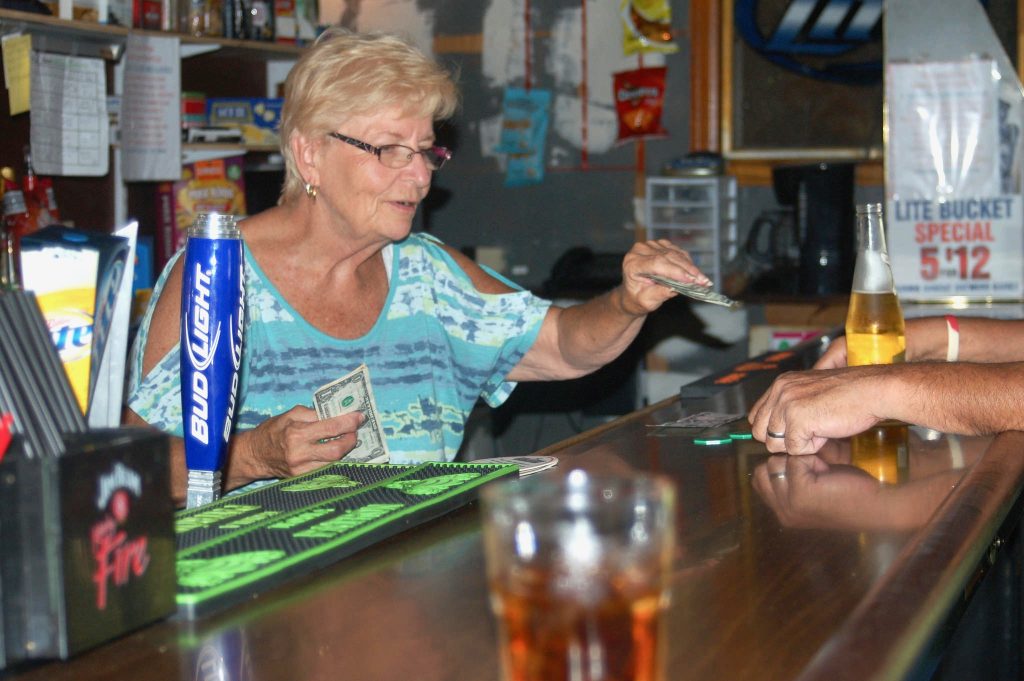
Sharon Ward, Safe Ride coordinator and treasurer of the Milwaukee County Tavern League, tended bar at The Last Drop, 1979 S. 15th St., until it closed a few months ago. Photo by Edgar Mendez.
In the late 1970s and ‘80s business was so good at Orchard Inn, a neighborhood pub on South 3rd Street and West Orchard, pool leagues ran morning, evening and midnight to accommodate three shifts of blue-collar workers who strolled in from nearby factories including Allen Bradley—now Rockwell Automation and Grede Foundries — since closed, recalled its former owner Sharon Ward.
When Ward, SafeRide coordinator and treasurer of the Milwaukee County Tavern League, and her late husband purchased Orchard Inn in 1975, it was one of thousands of neighborhood pubs in Milwaukee, she said. Like many others it served a vital function for patrons looking to catch more than just a buzz.
“The corner bar was the area’s social hub; it’s where you felt the pulse of the neighborhood and found out what was going on in your community,” Ward said.
Parents knew each other’s kids and kept a watchful eye, holidays were celebrated together there and when a family was having a tough time financially they turned to their friends at the bar for help, she added. But in the city that once touted itself as the “beer capital of the world,” and is still home to MillerCoors, the tavern culture generations of Milwaukeeans grew up with is fading away in some neighborhoods, as an older, simpler style of life moves to the slow lane to accommodate the accelerated pace of today’s society.
Nowhere is that change more evident than Milwaukee’s South Side, where day care centers, houses of worship, corner stores and residences occupy properties that for decades had been bars. A drive down South 13th Street or West Cleveland Avenue serves as a reminder of just how prevalent corner bars were at one time, and provides evidence that many old-time bars are now closed. Faded marquees and other signage are all that is left.
According to a Milwaukee Neighborhood News Service analysis of data provided by the City of Milwaukee, 40 percent of businesses with tavern licenses in 2012 in the 53204 ZIP code (which includes the Walker’s Point, Walker Square and Clarke Square neighborhoods), where Orchard Inn was located, and the neighboring 53215 ZIP code have now closed for any reason. In 53215 (which includes the Polonia, Lincoln Village and Silver City neighborhoods), 40 of 85 taverns, including stalwarts such as Ducky’s, Grady’s Saloon, Kornerstone Pub, and Frank and Barb’s Silver City Bar, have closed in the past five years (see accompanying maps).
“Back in the day you could walk to a bar on every corner and it’d be busy. Didn’t matter if it was 8 in the morning or 8 at night,” recalled Brian Schmidt, as he sipped from an 8-ounce tapper of Pabst at Richies Pub, 1998 S. 11th St. Richies is one of a dwindling number of South Side bars that have been open for decades, said its owner and namesake, Richie Dobs. He’s stayed in the bar business by keeping his prices low and hiring good bartenders, though he plans to retire soon and hopes to find a new owner for the bar, which typically closes by 7 p.m. and serves a racially mixed clientele that includes blue-collar workers and retirees.
Jim Rydzewski, owner of Bob-E-Lanes, 2932 S. 13th, bought his tavern/bowling alley from his parents in 1981. He said he’s seen many a bar in the neighborhood close during the three and half decades he’s been in business.
“Yeah Nick down the block, he died so his bar closed,” said Rydzewski, pointing south. He’s in his 60s now, and said he also hopes to find a new owner when he’s ready to retire in a few years.
“It would be a shame for this place to close after all the money I spent improving it,” he said of the bar, which runs daytime pool leagues daily and in the morning every other Monday.
Not everyone views a decline in the number of bars on the South Side as a negative. Ald. Jose Perez, who represents the 53204 ZIP code, said one of his memories growing up in the Walker Square neighborhood was seeing a dead body lying in the street outside of a tavern on South 10th Street and West Walker. Perez said his mother collected signatures in the neighborhood to have the bar shut down.
“Bad things happen at bars and they have for a long time,” Perez said.
In addition to increased crime, which has made some neighborhood pubs less desireable to visit or run a business in, the corner bar in Milwaukee is becoming a relic for a number of reasons, according to James Draeger, historic preservation officer for the Wisconsin Historical Society and author of the book, “Bottoms Up: A Toast to Wisconsin’s Historic Bars and Breweries.” The long list includes issues related to licensing, tougher drunken driving laws sparked by the Mothers Against Drunk Driving movement, and ironically an increase in driving, which opened up the city for residents to visit bars in other areas, whereas in the past they likely would’ve walked down the block.
“A lack of transportation in the early 19th century created a legacy of walkable neighborhood taverns in Milwaukee,” Draeger said. In addition, he said, tenements and small houses in 19th century Milwaukee limited the ability for people to host friends, which made the tavern a more suitable place to get together.
There are other basic reasons for the decreased number of bars that are associated with modern times, such as more entertainment options and the fact that mass communication has made taverns less critical to social life, Draeger added.
“Taverns aren’t really about the drinking; they exist because of the social life of the tavern. People want to meet people, or meet with friends and those functions were as relevant today as they were 50 years ago, but people do it in many different ways now,” Draeger said.
The industrial crash that began in the ‘70s and continues today devastated many local communities and the taverns that served them.
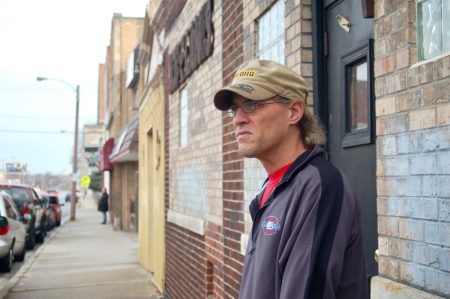
South Sider Matt Olson stands outside of Bob-E-Lanes, 2932 S. 13th, a tavern/bowling alley in the Polonia neighborhood that’s remained open for decades. Photo by Edgar Mendez.
“We lost tool and die makers, mechanics, laborers and machinists. When we lost a big chunk of the labor pool we lost a bunch of customers as well,” said Ward, who tended bar at The Last Drop on South 15th Street and West Rogers until it too closed a few months ago.
Ward and her husband purchased the bar in 1985 and ran it as Wardski’s until she sold it in 2009. She stayed on as a day-shift bartender until it closed, serving the aging client base she’d built for decades consisting almost entirely of retirees.
A decline in customers and profits made running a neighborhood tavern less attractive to the next generation, she said, so when tavern owners died or were too old to run their pub, their kids didn’t want it.
“The next generation didn’t see the value in owning this type of business nor putting in the time and effort it takes because it’s a 24-hour-job. They went to college instead,” Ward said. Rydzewski said his kids helped out at the bar when they were younger, but they wouldn’t be taking over the family business either. “They all got kids and are married. They got good jobs. They’re not interested in running this place,” he said.
Despite the decline in neighborhood pubs on the South Side, the number of businesses with a tavern license in the city increased from 1,096 in 2001 to 1,356 in 2016, according to data provided by the city. Those numbers could be inflated. The Milwaukee Neighborhood News Service found many are actually closed. Much of the new business can be attributed to an increase in the number of specialty bars such as Drink Wisconsinbly Pub & Grub, Oscar’s Pub & Grill, Buffalo Wild Wings and other locations that generate business from food, craft cocktails and a large selection of tap and bottled beers, said Draeger.
One example of a traditional-turned-specialty bar is the popular Walker’s Point pub, Steny’s Tavern & Grill, 800 S. 2nd St. Jerry Steny opened the bar in 1985 and said that at the time Walker’s Point was the top bar area in Milwaukee. Eventually though, his younger clientele shifted to Water Street downtown and Brady Street on the East Side when crime increased in the ‘90s and 2000s. The bar struggled until his son Ryan Steny came aboard in 2010 with the idea to specialize in craft beer and sports. Business has been booming since.
“It’s important to set yourself apart from the rest. Competition is fierce and you need to stand out,” Steny said.
Those who didn’t innovate and were resistant to change, including many older tavern owners, haven’t survived as a result, Draeger said.
“Many of the neighborhood tavern providers are elderly and aging out and don’t want to change. They don’t want to have 20-somethings and 30-somethings in their bar; they want people like them,” he added.
The newer bars that are chains, leased or run by general managers and others who don’t live in the neighborhood are a far cry from the days when bars hosted block watch meetings and Christmas dinners, said Ward. The evolution of bars such as Steny’s and the influx of chains has dealt a heavy blow to the neighborhood pub, one from which it’s unlikely to recover, said Ward.
“Those days are gone. Running a bar in the neighborhood was a good way of life and a good thing for the neighborhood. But our bars are dying off and we’re dying with them,” Ward said.
This story was originally published by Milwaukee Neighborhood News Service, where you can find other stories reporting on eighteen city neighborhoods in Milwaukee.


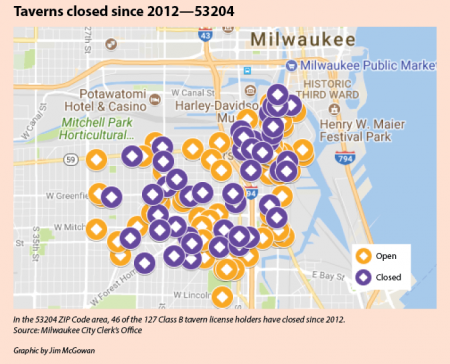
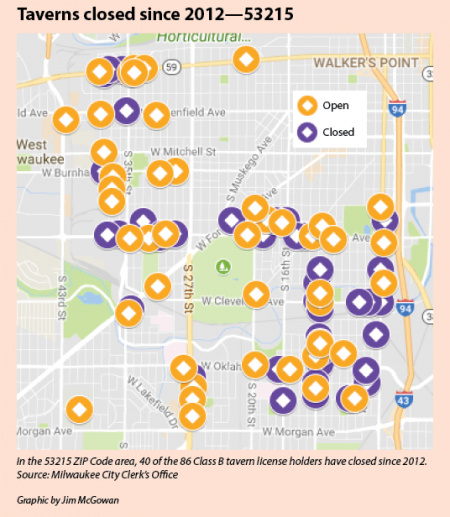
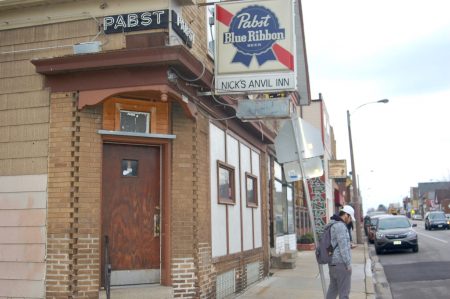




















Oh well, make way for the shiny new cannabis dispensaries all the rich successful people and millenials prefer anyways. Times and preferences change. In all the old run down seedy neighborhoods I grew up in in Seattle once the legal cannabis stores opened up TONS of big money poured in, hip retail stores and yuppie favorites like Trader Joe’s and Whole Foods moved in, condos went up and good people with good jobs moved in. In short, in less than a year the entire neighborhoods gentrified and while there are downsides to unmitigated gentrification I think most agree Milwaukee could use a little more.
Good article.
A trip down South Side memory lane. In the late 1940s, when my best friend Connie and i were 2nd graders, we would go out on Friday and Saturday nights with cigar boxes, which contained two colors of shoe polish, a rag and a brush.We were South Side shoeshine boys. Our customer base consisted entirely of the patrons of the 3 bars on National Avenue between 26th and 27th Streets. We would always make our nut in that single block.
It is hard to imagine any parent letting a 7 year old out of the house on Friday and Saturday night alone today, but I can’t remember anyone thinking there was any danger. The three National Avenue bars were Johnny’s Super Bar, Pauls and the famous/infamous National Liquor Bar, which no one mistook for a government agency. Looking back, there was a pretty clear class hierarchy in these bars. Johnny’s was pure factory and railroad workers, Paul’s patrons were more of what my mom would call “a better class of people,” and the National Liquor Bar, aka Sol’s, kind of the low class venue, and also the place where more people were drunk.
Except for Paul’s, the clientele of Johnny’s and Sol’s was almost entirely men, and despite the fact that we were two little street urchins, we were not seen a being “cute.” We got business because these guys wanted a shoeshine, and were willing to pay 25 cents for a “genuine spit shine.” Of the neighbors that I encountered, most were men trying to get away from their wives and kids for awhile, and also, I think a big deal, to get out of the small, dark, cramped houses that we lived in, coupled with the dirty, noisy workplaces where most of the men were employed. I don’t ever remember seeing a man from our block wear a shirt and tie to work.
The postwar boom was just getting underway, and these bars were always crowded, with television just becoming a reason to stay home. So people had some money to spend, including on us. For example, on a good night, Connie and I could make $3 each, more than $40 in today’s money. A candy bar was 5 cents.
But, there was a big downside to this. I remember a lot of drunkenness and the meanness that went with it. Sometimes, these men were even mean to two little kids, for example, if you accidentally got some black polish on their white socks, and they would stiff you. But that was pretty unusual.
Probably the most important thing was that a couple of second graders could be out making money and it was hard to imagine anything bad happening to them, because there was always someone from the community who knew them and kept an eye on them. And the other side of this equation was that, if you did something wrong, your parents knew about it before you got home. It was the adults against the kids, and the bars were one of the communications centers for keeping us in line. In retrospect, it was a great thing because it meant that you could do things like we did and still feel like you were living an adult free childhood.
What about the impact of the smoking ban since 2010?I don’t smoke but I can’t count how many people stand outside places like the American Legion Post at 92nd and Beloit lighting up.These people claim they are losing their liberties but what about those of us who want the liberty to go someplace for a drink without putting up with someone else’s cigarette smoke?I don’t miss the days coming home with clothes smelling like a Ash Tray!
Very good article and I loved Frank’s take on it. The good alderman pointed out the fights and deaths that no one in their right mind will miss but missed the gist of the article, that bars were a social club as one could always drink cheaper at home. Steny rightly notes that without food or big screen TV’s your business will wither away.
Frank, what wonderful memories that you’ll forever cherish. Such a different time! I grew up during the 1960s in the Old South Side. We rented, so did move frequently, but we always stayed on the Old South Side. There really was a tavern, sometimes two, at almost every intersection. My memories of those old taverns is that the proprietors were usually kind older people who would always have a bag of candy behind the bar for the neighborhood kids. The taverns were renowned for being especially generous during Trick or Treating.
We kids always walked to everything, or took the bus (I think the fare for kids was 10 cents) if we wanted to go Downtown to the Central Library or the “new” Museum. The only place we were told to stay away from after dark was Kosciuszko Park because the “hoodlums” would hang out there.
Unfortunately, we moved to the “classier” (and far less charming) Northwest side when I was high school age, so never got the chance to patronize those old taverns when I attained the back then legal drinking age of 18.
Many neighborhood bars provided income for the kids of those factory workers & small business employees, on the North Side, too. In the late ’50s from about age 10 on at Ray Laessig’s on 20th & Hopkins I stocked the coolers behind the bar & — since it was illegal to refill bottles or re-use the brand & tax labels — I took them from the basement chute & made sure to break them & deface the stamps. Fun, & like many taverns Ray also had an attached hall for parties, receptions & meetings (like unions) & such, so I swept the floor afterwards & arranged chairs & tidied up, just as I shoveled snow in those days when it was really a lot to deal with. Once as a kid crouched unnoticed behind the bar working I even heard a lady talking to my part-time bartender Step-dad Kenny about the time he went home with her — but I never told my Mom. How many grade-schoolers get the chance to earn a little extra like that these days?